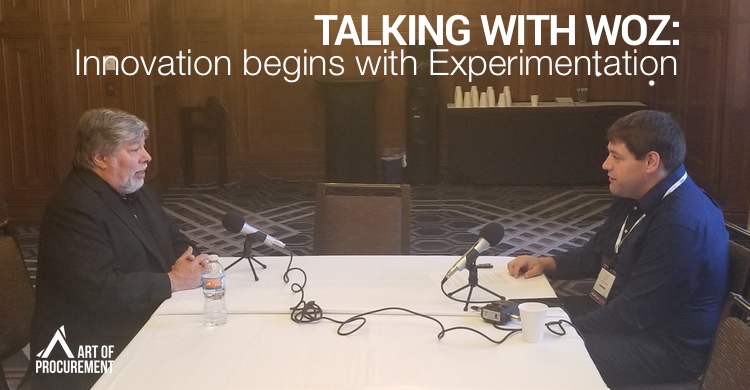
I recently had an amazing opportunity to interview Apple co-founder Steve Wozniak at the Coupa Inspire conference in San Francisco. If you’d like to hear our entire conversation on the Art of Procurement podcast, you can listen in below:
A few points from our conversation stood out to me as particularly critical to procurement at this point in our evolution, and I’m going to share them in a 3-part series of posts between the AOP and Coupa blogs.
As Wozniak told the crowd in San Francisco:
“Always design something new that does not come from anyone else’s design.”
Although most people naturally associate innovation with the new results it generates, few of us have much first-hand experience with true innovation. The fact of the matter is, you can’t create something new using a legacy approach. The drive to innovate will require us to experiment with unproven approaches to spend management and supplier collaboration. And yet – we can’t expect to succeed with everything we try, which means procurement needs to (a.) be prepared for failure and (b.) alter our mindset towards risk.
Wozniak described innovation as a natural process for people who do it well. They don’t just blaze new trails because their company asks them to, it is an inherent part of how they work. “The innovators are the types of people that grew up their whole life as ‘makers’”, he told me. “They would take little ideas and turn them into stuff that wasn’t worth money maybe, but little robots or software projects.”
If the potential for innovation is born rather than taught, we need to be on the lookout for it all the time and at all levels of the organization. Empowering distributed decision making through procurement processes and technology allows innovation to take root, whether it begins at the management level or the entry level. Every good idea, no matter the source, needs to be given an honest opportunity to succeed: alternate specs, brand new suppliers, and collaborative business relationships.
If we follow Woz’ advice not to try and design something new on the foundation of a pre-existing idea, simply improving existing processes is not enough. Instead, procurement should hold fast to the principles we have always believed in – resource efficiency, transparency, and supply base capability – and experiment with new ways to apply them.
For example, leading procurement organizations are looking at new ways to measure the cost and return products and services. By leveraging the altered economics of the circular economy, paying for access to a resource (or outcome) rather than buying an asset outright, or exploring the capabilities of robotic process automation instead of automatically outsourcing, procurement may be able to create expanded value in the long run – even if it requires a larger upfront investment or breaks the line of ‘apples to apples’ savings calculations.
When we combine the ideas that innovation happens naturally, that it may be accompanied by increased risk, and that it does not necessarily build on existing frameworks, it is hard to deny that innovation must be something an individual wants rather than needs to do. The Apple story certainly embodies all of these truths. Despite the fact that they are one of the most admired companies on the planet, their path has not been straight or easy. Apple’s perseverance – and the fact that innovation is endemic to their organizational culture – has been key to seeing them through the setbacks on their innovation journey.
In Part 2 of this series I will share Woz’ positive outlook on the evolving role of AI and its impact on procurement talent.




